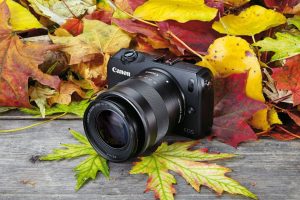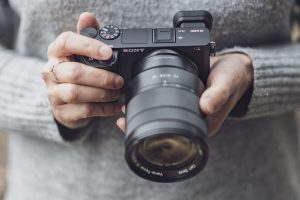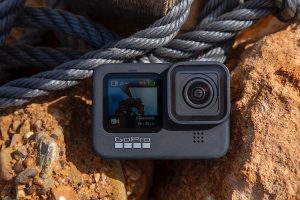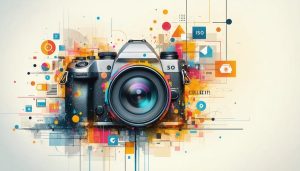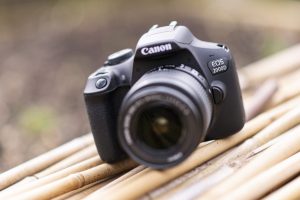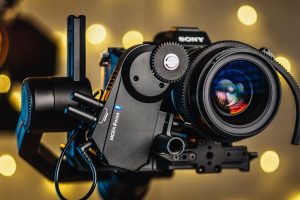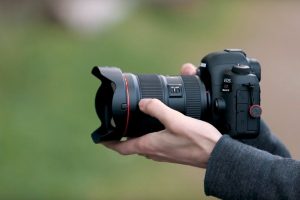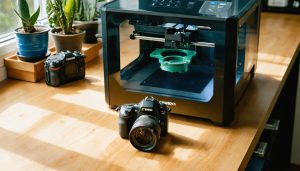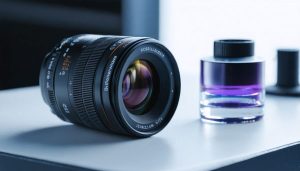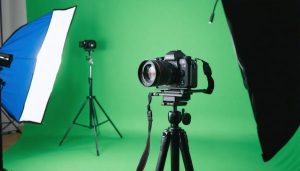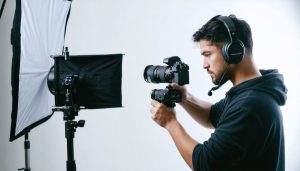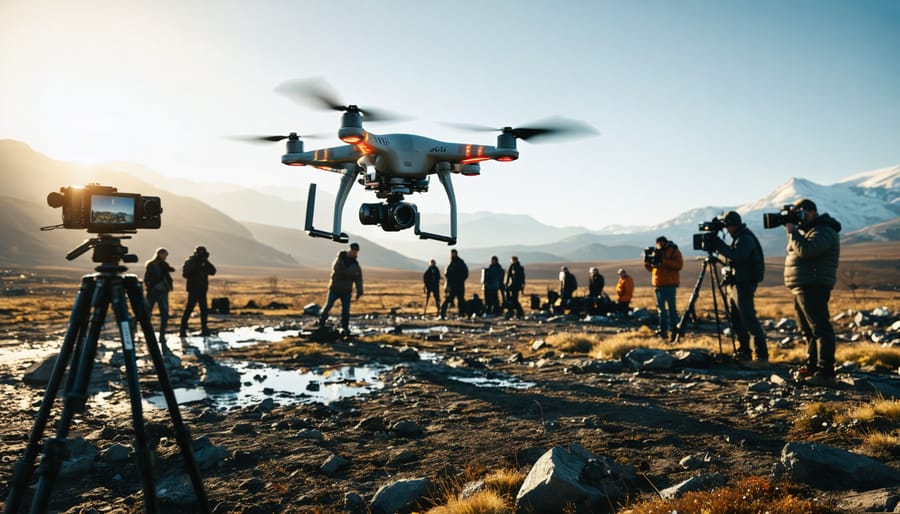
Drones have revolutionized modern cinematography, transforming what was once impossible into everyday reality. From sweeping landscape shots that rival Hollywood productions to intimate wedding videos that capture moments from breathtaking angles, aerial cinematography has become an essential tool in every serious filmmaker’s arsenal.
The integration of drone technology into filmmaking isn’t just about capturing stunning aerial footage – it’s about expanding the creative possibilities of visual storytelling. Modern drones combine sophisticated flight controls, stabilization systems, and high-resolution cameras to create shots that would have required helicopters, cranes, or complex rigging systems just a decade ago.
Today’s cinematographers can execute complex camera movements with precision, whether gliding through narrow spaces, revealing vast landscapes, or following fast-moving subjects with unprecedented fluidity. This technological advancement has democratized aerial filmmaking, making it accessible to independent creators and major studios alike.
As we delve into the world of drone cinematography, we’ll explore how these aerial platforms have become more than just tools – they’re now an integral part of the filmmaker’s creative vision, offering new perspectives and possibilities that continue to push the boundaries of visual storytelling. Whether you’re a seasoned director or an aspiring content creator, understanding drone cinematography isn’t just about keeping up with trends – it’s about embracing a fundamental shift in how we capture and share stories through motion pictures.
Essential Drone Equipment for Cinematic Shots
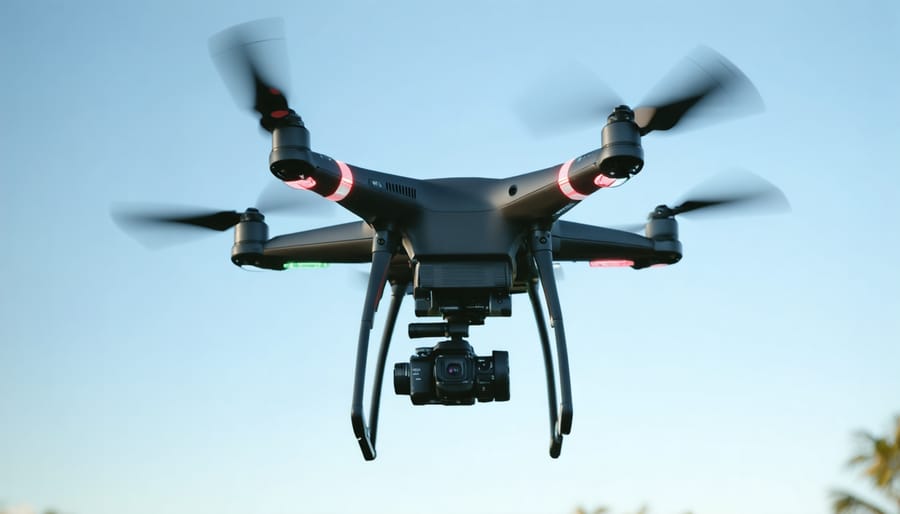
Camera and Gimbal Systems
The heart of any aerial cinematography setup lies in its camera and stabilization system. Modern drone cameras range from built-in options on consumer models to professional cinema cameras capable of capturing stunning 6K or even 8K footage. The choice of camera significantly impacts not just image quality, but also your drone’s flight characteristics and capabilities.
Professional cinematography drones typically support interchangeable lens systems and can carry payloads like the RED KOMODO or ARRI ALEXA Mini LF. These setups, while offering exceptional image quality and cinematic lighting techniques, require careful consideration of weight distribution and flight time limitations.
At the core of smooth aerial footage is the gimbal system – a sophisticated 3-axis stabilization mechanism that compensates for drone movement and vibration. Modern gimbals use advanced algorithms and motors to maintain horizon level and eliminate unwanted shake, even in challenging wind conditions. The DJI Ronin series and the FreeFly MōVI Pro are popular choices among professionals, offering precise control and reliability.
Payload capacity is crucial when selecting your setup. While consumer drones like the DJI Mavic series come with integrated camera systems, professional rigs must balance camera weight, lens choices, and additional gear like filters or follow focus systems. Remember that heavier payloads affect flight time and maneuverability – a fully loaded cinema camera rig might reduce flight time by 40% or more compared to lighter setups.
When choosing your system, consider your specific needs: image quality requirements, shooting conditions, and the type of shots you’ll typically capture. Sometimes, a more compact setup with a high-quality built-in camera might serve better than a heavy cinema rig, especially for fast-moving or tight-space shots.
Drone Features for Professional Footage
When it comes to capturing cinematic footage from the sky, not all drones are created equal. Professional-grade drones need specific features to deliver those breathtaking aerial shots that elevate production value. Flight time is arguably the most critical factor, with top-tier drones offering 25-35 minutes of air time, allowing cinematographers to capture extended sequences without interruption.
Camera stability is paramount, and professional drones come equipped with advanced 3-axis gimbals that ensure smooth, jitter-free footage even in challenging conditions. Look for models featuring adjustable gimbal settings and dampening systems that compensate for wind and drone movement.
Intelligent flight modes have revolutionized aerial cinematography. Features like orbital shots, which automatically circle a subject while maintaining perfect framing, and waypoint navigation for pre-programmed flight paths, enable complex shots that would be nearly impossible to execute manually. Cable cam and spotlight tracking modes are essential for dynamic action sequences.
Range capabilities matter too, especially for landscape and establishing shots. Professional drones typically offer 5-8 kilometer transmission ranges, though local regulations often restrict actual flight distances. More importantly, they provide reliable dual-band transmission systems that maintain crystal-clear video feeds.
Camera specs deserve careful consideration. Look for drones supporting adjustable aperture, high bitrates (100Mbps+), and professional color profiles like D-Log or D-Cinelike. Advanced obstacle avoidance systems operating in multiple directions provide peace of mind when flying near structures or through complex environments.
For professional results, prioritize drones offering manual camera controls, including ISO, shutter speed, and white balance adjustments. These features, combined with robust build quality and reliable safety systems, form the foundation for capturing truly cinematic aerial footage.
Mastering Cinematic Drone Shots
Essential Flight Techniques
Mastering essential flight techniques is crucial for capturing those breathtaking cinematic shots that make drone footage so compelling. Let’s explore the fundamental movements that form the backbone of aerial cinematography.
The Reveal is perhaps the most iconic drone shot, where you start low and slowly rise up to unveil a landscape or subject. Think of it as pulling back the curtain on your scene – timing and smooth acceleration are key to nailing this technique.
The Orbit, also known as the wraparound, involves circling your subject while maintaining it as the center point. This movement creates dynamic footage that adds depth and perspective to your story. Start with a wider orbit before attempting tighter circles, and remember to keep your movements fluid.
Tracking shots are essential for following moving subjects. Whether you’re capturing a car racing down a road or a hiker traversing a mountain trail, maintaining a consistent distance and speed is crucial. Practice flying sideways while keeping your camera focused on the subject.
The Top-Down shot has become increasingly popular, offering a unique bird’s-eye perspective. Fly your drone directly overhead and slowly descend or ascend while keeping the camera pointed straight down. This technique works particularly well for revealing patterns, architecture, or crowd scenes.
For smooth footage, master the art of subtle stick movements. Think of your controller as a fine-tuning instrument – gentle inputs result in cinematic motion, while jerky movements can ruin your shot. Start practicing at slower speeds until you develop muscle memory for these controlled movements.
Remember to incorporate the “rule of thirds” in your composition and maintain a consistent speed throughout your movements. When executing any of these techniques, plan your shot beforehand and ensure you have enough battery life to capture multiple takes. The key to professional-looking footage lies in smooth execution and patient practice of these fundamental movements.
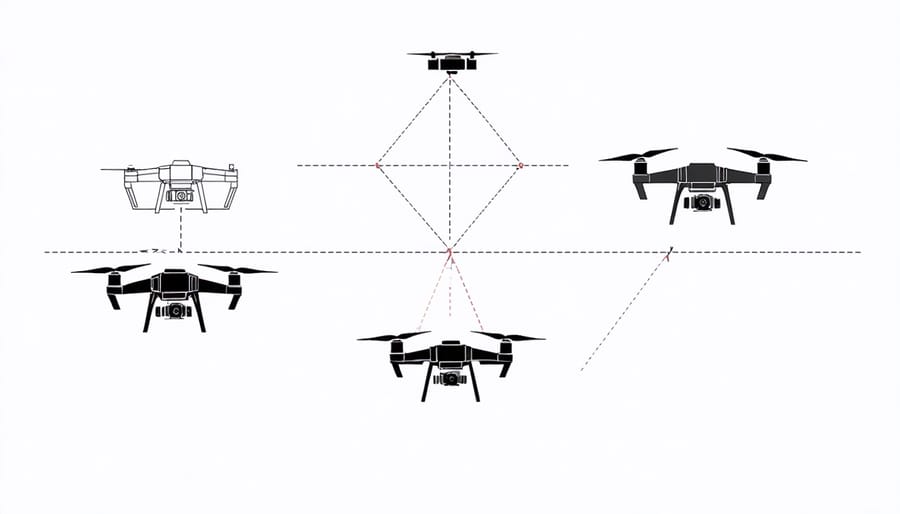
Advanced Camera Movements
Mastering dynamic camera movements with drones opens up a whole new dimension of creative possibilities in cinematography. Let’s explore some advanced techniques that can elevate your aerial footage from good to extraordinary.
The reveal move is perhaps one of the most dramatic drone techniques, where you start with a tight shot on your subject and slowly pull back to unveil the grand scale of the location. This works particularly well for architectural shots or landscape transitions. To execute this perfectly, maintain a constant speed and use your drone’s trajectory planning feature if available.
The orbital dolly, sometimes called the “reveal spiral,” involves circling your subject while gradually ascending or descending. This technique requires precise control and practice, but creates a mesmerizing three-dimensional perspective that’s impossible to achieve with traditional camera equipment.
The vertical reveal with a tilt is another powerful move, where you fly straight up while slowly tilting the camera down (or vice versa). This creates a stunning perspective shift that can transition between scenes or reveal unexpected elements in your frame.
For more complex movements, try combining multiple techniques. For example, start with an orbital movement that transitions into a reveal while adjusting altitude. Just remember to keep your movements smooth and purposeful – every motion should serve your story.
One often-overlooked technique is the “push-pull parallax,” where you fly toward or away from your subject while adjusting the zoom to maintain the same frame size. This creates a compelling shift in perspective that can add depth and drama to your shots.
Remember, smooth execution is crucial. Practice these movements in an open area before attempting them in actual shoots, and always prioritize safety over getting the perfect shot.
Composition Rules for Aerial Shots
Mastering aerial cinematography requires a solid understanding of visual composition principles, adapted for the unique perspective that drones provide. When shooting from above, the landscape becomes your canvas, and traditional rules take on new meaning.
Start by identifying strong leading lines in the landscape – roads, rivers, or architectural features that naturally draw the viewer’s eye through the frame. These elements are particularly powerful when captured from above, creating depth and directing attention to your subject.
The rule of thirds remains crucial but takes on new significance in aerial shots. Consider dividing your frame both horizontally and vertically, placing key elements at the intersection points. For landscape shots, try positioning the horizon line along the upper or lower third rather than dead center.
Symmetry and patterns become especially striking from an aerial perspective. Look for geometric shapes in urban environments, agricultural fields, or natural formations. These patterns can create visually stunning compositions that might go unnoticed from ground level.
Scale is another vital element in aerial cinematography. Include recognizable objects in your frame to provide context and help viewers understand the magnitude of the scene. A car, building, or person can serve as an effective reference point.
When capturing moving subjects, leave adequate headroom in the direction of movement. This technique, known as lead room or looking space, creates a natural flow and prevents your composition from feeling cramped or unbalanced.
Remember to consider the altitude’s impact on your composition. Lower heights emphasize details and textures, while higher altitudes reveal broader patterns and relationships between elements in the landscape.
Legal and Safety Considerations
Drone Regulations for Filmmakers
Before taking your drone to the skies for that perfect aerial shot, it’s crucial to understand and comply with drone regulations. In the United States, the Federal Aviation Administration (FAA) requires all drone pilots flying for commercial purposes, including filmmaking, to obtain a Remote Pilot Certificate under Part 107.
To get certified, you’ll need to pass a knowledge test covering airspace classifications, weather patterns, drone operations, and emergency procedures. The certification is valid for 24 months and must be renewed through a recurrent training course.
Key regulations include maintaining visual line of sight with your drone, flying below 400 feet altitude, avoiding restricted airspace, and not flying over people or moving vehicles. Night operations are permitted but require anti-collision lighting visible for three statute miles.
For film productions, you’ll often need additional permits depending on your location. Many cities and states have specific requirements for commercial drone filming, and you’ll need property owner permission when shooting on private land.
International filmmakers should note that drone regulations vary significantly by country. Some nations require additional licenses, while others may completely restrict drone usage for filming. Always research local laws and obtain necessary permits before planning drone shots abroad.
Remember that regulations are regularly updated, so stay current with the latest requirements through the FAA website and local aviation authorities.

Safety Protocols and Best Practices
Safety should always be your top priority when operating drones for cinematography. Before each flight, conduct a thorough pre-flight inspection of your drone, checking propellers, batteries, and control systems. Ensure all firmware is up to date and calibrate your compass and GPS systems in an interference-free area.
Always follow local aviation regulations and obtain necessary permits or certifications. In the US, commercial drone operators must have a Part 107 certification from the FAA. Keep your drone within visual line of sight and maintain a safe distance from people, buildings, and other aircraft.
Weather conditions significantly impact drone operations. Check wind speeds, precipitation forecasts, and visibility before flying. As a general rule, avoid flying in winds exceeding 20 mph or during any precipitation. Maintain awareness of your surroundings, including power lines, trees, and potential radio interference sources.
Create a pre-flight checklist and emergency procedures plan. This should include designated takeoff and landing zones, emergency landing spots, and communication protocols with your crew. Always carry spare batteries and ensure they’re fully charged before each flight.
Remember to respect privacy rights and property boundaries. Obtain necessary location permissions and inform relevant authorities or property owners of your filming activities. Having proper insurance coverage for your drone operations is also essential to protect against potential accidents or damage.
Post-Production Tips for Drone Footage
Color Grading and Stabilization
Raw aerial footage from drones often needs careful post-processing to achieve that cinematic look you’re after. The key lies in mastering professional color grading techniques and applying effective stabilization methods.
Start by correcting any exposure inconsistencies and white balance issues in your footage. Many drone cameras shoot in flat color profiles like D-Log or Cine-like D, giving you more flexibility in post-production. When color grading, focus on creating a consistent look across all your shots by adjusting contrast, saturation, and implementing LUTs (Look-Up Tables) that complement your creative vision.
For stabilization, while drones come with built-in gimbals, footage might still need smoothing in post. Software solutions like Warp Stabilizer in Premiere Pro or ReelSteady can work wonders on slightly shaky footage. Pay special attention to horizon lines – even a slight tilt can break the professional feel of your shots.
Remember to maintain natural motion in your footage. Over-stabilization can create that artificial, floating look that viewers find distracting. The goal is to achieve smooth, cinematic movement while preserving the dynamic nature of aerial cinematography.
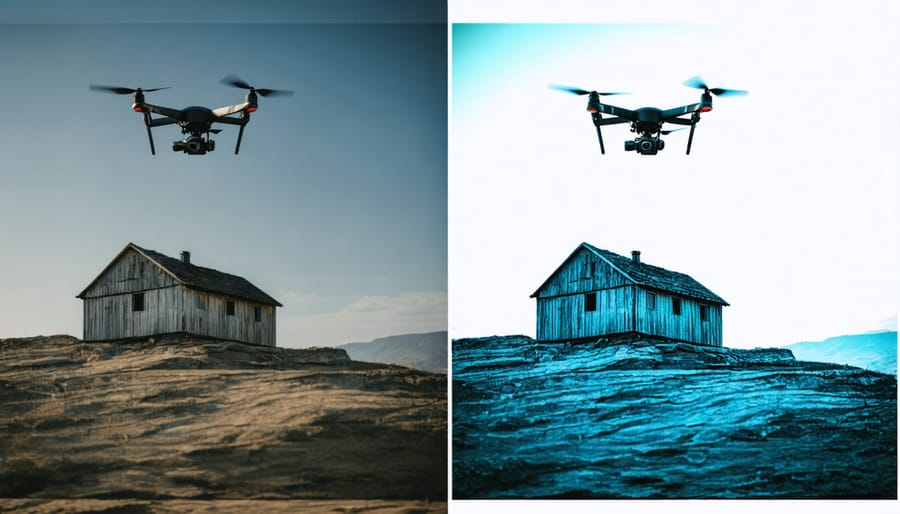
Integrating Aerial Shots
Seamlessly integrating aerial footage into your production requires careful planning and execution, both during filming and in your post-production workflow. Start by storyboarding your aerial shots alongside ground-based footage to ensure a cohesive visual narrative. Consider the pacing of your transitions – sudden cuts from ground to air can be jarring, so try using natural movement cues or matching shot directions to create fluid sequences.
Color grading plays a crucial role in integration. Drone footage often captures different color temperatures and exposure levels compared to ground cameras, so take time to match these elements in post. Using LUTs (Look-Up Tables) specifically designed for your drone’s camera can help achieve consistency with your primary footage.
When planning drone movements, think about how they’ll complement your ground shots. Gentle reveals work well as establishing shots, while dynamic movements can create emotional impact during key story moments. Remember that not every aerial shot needs to be dramatic – sometimes a subtle high angle adds just the right perspective without overwhelming the viewer.
For the smoothest integration, maintain consistent frame rates between your drone and ground footage, and consider using speed ramping to seamlessly blend different shooting speeds.
As we’ve explored throughout this article, drone cinematography has revolutionized the way we capture and create visual content. From sweeping landscape shots to dynamic action sequences, drones have opened up countless creative possibilities that were once impossible or prohibitively expensive to achieve.
The future of drone cinematography looks incredibly promising. Advances in technology continue to bring us more compact, stable, and intelligent drones with improved flight times and camera capabilities. We’re seeing the emergence of AI-powered flight patterns, enhanced obstacle avoidance systems, and increasingly sophisticated tracking features that make complex shots more accessible to creators at all skill levels.
Industry trends suggest that drones will become even more integrated into mainstream film production, with specialized models catering to different filming needs. The development of quieter propulsion systems and improved low-light performance will address current limitations, while advances in battery technology will extend flight times and operational range.
For aspiring drone cinematographers, there’s never been a better time to enter the field. As regulations become more standardized and technology more accessible, the barriers to entry continue to lower. However, success still depends on mastering both the technical aspects of drone operation and developing a keen eye for compelling composition.
Remember that while technology enables incredible shots, it’s your creative vision and storytelling ability that truly sets your work apart. Stay informed about industry developments, practice regularly, and never stop pushing the boundaries of what’s possible in aerial cinematography.





